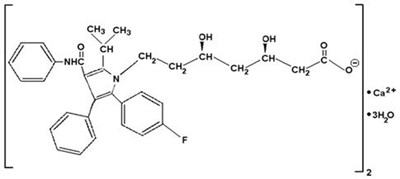Product Images Atorvastatin Calcium
View Photos of Packaging, Labels & Appearance
- Chemical Structure - atorvas tab 01
- 02 - atorvas tab 02
- 03 - atorvas tab 03
- 04 - atorvas tab 04
- PRINCIPAL DISPLAY PANEL - 10 mg Tablet Bottle Label - atorvastatin calcium 10
- PRINCIPAL DISPLAY PANEL - 20 mg Tablet Bottle Label - atorvastatin calcium 20
- PRINCIPAL DISPLAY PANEL - 40 mg Tablet Bottle Label - atorvastatin calcium 40
- PRINCIPAL DISPLAY PANEL - 80 mg Tablet Bottle Label - atorvastatin calcium 80
Product Label Images
The following 8 images provide visual information about the product associated with Atorvastatin Calcium NDC 82137-017 by Lepu Pharmaceutical Technology Co., Ltd., such as packaging, labeling, and the appearance of the drug itself. This resource could be helpful for medical professionals, pharmacists, and patients seeking to verify medication information and ensure they have the correct product.
03 - atorvas tab 03
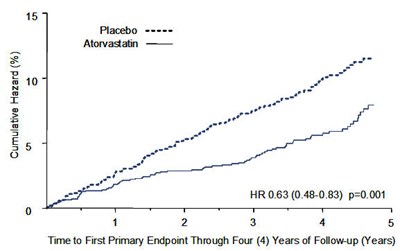
This is a graph that compares the cumulative hazard (percentage) of the placebo group to that of the group receiving Atorvastatin for four years. The hazard ratio (HR) for Atorvastatin is 0.63, and the p-value is 0.001, indicating a significant reduction in the primary endpoint. The x-axis represents time to the first primary endpoint in years, and the y-axis represents the cumulative hazard percentage.*
04 - atorvas tab 04
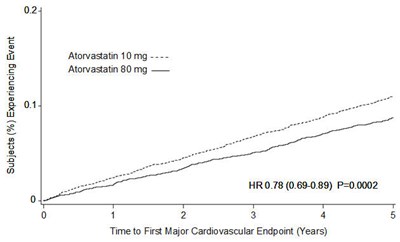
The text shows a comparison of subjects who experienced a major cardiovascular endpoint while taking Atorvastatin at two doses (10mg and 80mg). The results showed a significant difference between the two doses with the group taking Atorvastatin 80mg experiencing fewer cardiovascular events. The data is presented graphically over a 4-year period.*
PRINCIPAL DISPLAY PANEL - 10 mg Tablet Bottle Label - atorvastatin calcium 10
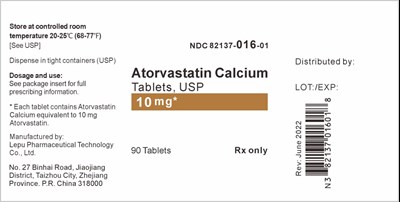
Atorvastatin Calcium Tablets, USP can be stored between 20-25°C (68-77°F) in tight containers. Each tablet contains 10 mg Atorvastatin Calcium, and the full prescribing information can be found in the package insert. They are manufactured by Lepu Pharmaceutical Technology Co., Ltd. in Taizhou City, China, and distributed by an unspecified company. The NDC is 82137-016-01, and the product is only available with a prescription. Revision is dated June 2022.*
PRINCIPAL DISPLAY PANEL - 20 mg Tablet Bottle Label - atorvastatin calcium 20
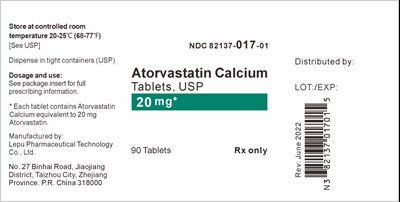
This is a label for Atorvastatin Calcium Tablets. The recommended storage temperature is between 20-25°C (68-77°F) and they should be dispensed in tight containers. For dosage and usage, the package insert should be consulted for full prescribing information. Each tablet contains Atorvastatin Calcium equivalent to 20mg Atorvastatin. The tablets are manufactured by Lepu Pharmaceutical Technology Co., Ltd in Taizhou City, Zhejiang Province, China. The NDC number is 82137-017-01, and the tablets are only available by prescription. The label was revised on June 2021.*
PRINCIPAL DISPLAY PANEL - 40 mg Tablet Bottle Label - atorvastatin calcium 40
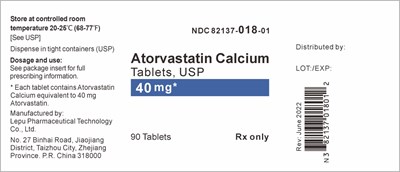
This is a prescription drug package containing 90 tablets of Atorvastatin Calcium equivalent to 40 mg Atorvastatin per tablet. The drug details indicate that it should be stored in tight containers at a controlled room temperature of 20-25°C (68-77°F) and should be dispensed as per the USP guidelines. The package insert contains the necessary information regarding its dosage and usage. The drug is produced by Lepu Pharmaceutical Technology Co., Ltd in China and distributed under NDC82137-018-01.*
PRINCIPAL DISPLAY PANEL - 80 mg Tablet Bottle Label - atorvastatin calcium 80
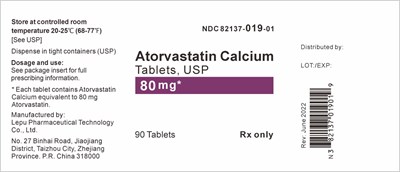
This is a medication called Atorvastatin Calcium and it comes in tablets containing 80mg of Atorvastatin. It is recommended to be stored at room temperature between 20-25°C (68-77°F) and dispensed in tight containers. The packaging insert should be consulted for full prescribing information. The medicine is manufactured by Lepu Pharmaceutical Technology Co. Ltd. and distributed by an unknown company. The NDC number is also provided.*
* The product label images have been analyzed using a combination of traditional computing and machine learning techniques. It should be noted that the descriptions provided may not be entirely accurate as they are experimental in nature. Use the information in this page at your own discretion and risk.
